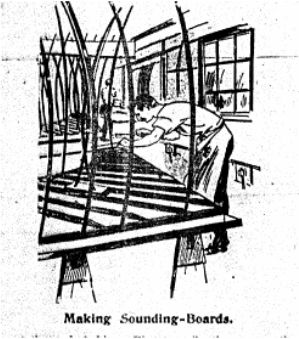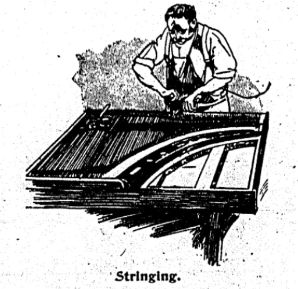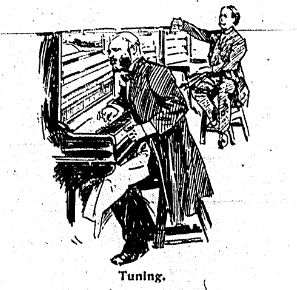|
July 25, 1896 |
THE ILLUSTRATED LONDON NEWS |
119 |
||||
|
|
||||||
The Creation of a Pianoforte. |
||||||
|
A VISIT TO MESSRS. JOHN BRINSMEAD AND SONS'. THE TIMBER STACKS.It needs an exhaustive visit to a manufactory such as Messrs. John Brinsmead and Sons' to gain some inkling of the evolution of the instrument. The piano-builder who has laid down his plan and determined his scale must bring to the work of execution a thorough knowledge of acoustics, must know how to apply strictly mathematical principles, and must show practical adaptability of materials to the end proposed, which nothing but long experience can give. In each and every one of the eighteen extensive workshops where the separate various processes of piano-making may be seen the details are worked out in the most thorough fashion. First to strike the eye are the stacks of timber stored in the yard, containing sufficient material for the production of thousands of pianos. Here are sections each carefully marked - for a complete history is recorded in the books of the firm for every plank from the date of its
entry - of mahogany from various parts of the world. Switzerland and Austria send their firs, which give the finest resonance to the sounding-board. Norway and Sweden contribute their pines. Our home forests supply oak and
beech - this chiefly from Arundel - stoutest of woods to bear the stress and strain. The walnuts of Russia and Italy, the satin-wood of India, cedar from the Philippines, rosewood from South
America, the kauri of New Zealand, and other valuable trees have all special qualities useful in the making of frame or case. None of this material is used until put to the severest test that a storage of several years can give. Under the open air and in the dry heat-room every particle of moisture is extracted
before a plank goes to the saw-room, there to be
cut and moulded to the requisite shape.
First to strike the eye are the stacks of timber stored in the yard, containing sufficient material for the production of thousands of pianos. Here are sections each carefully marked - for a complete history is recorded in the books of the firm for every plank from the date of its
entry - of mahogany from various parts of the world. Switzerland and Austria send their firs, which give the finest resonance to the sounding-board. Norway and Sweden contribute their pines. Our home forests supply oak and
beech - this chiefly from Arundel - stoutest of woods to bear the stress and strain. The walnuts of Russia and Italy, the satin-wood of India, cedar from the Philippines, rosewood from South
America, the kauri of New Zealand, and other valuable trees have all special qualities useful in the making of frame or case. None of this material is used until put to the severest test that a storage of several years can give. Under the open air and in the dry heat-room every particle of moisture is extracted
before a plank goes to the saw-room, there to be
cut and moulded to the requisite shape.
THE EVOLUTION OF THE SOUNDING BOARDNow comes the fundamental portion of the piano - the back, with the sounding-board - on the excellence of which depends the piano's beauty of tone. A flaw in this vital part would entail an early failure of the instrument hence the special attention given to strengthen its construction, to vary its thickness, and to perfect its scale. By the latest of their patented improvements the firm have discovered a means of distributing the resonance more equally over the whole board. To withstand the enormous strain of some twenty-five tons, which is the calculated tension of the strings in a Brinsmead and Sons' upright grand piano, the iron frame must be of equal warrant with that of the sounding-board. The metal castings employed differ little so far as quality is concerned in the Brinsmead pianos of different grades, the principal variation being the amount of "finish" and decoration given in each case. But the "wrest-plank" of wood is a greater marvel of special design. Compact of three layers of wood with a core of beech protected by veneer from damp, the wrest- plank holds the peg to which the tuner applies his key when bringing the strings to their proper p itch. The peculiar form of wrest-plank invented and used by the firm has now stood the test of many years. None has ever split, and the dreaded breakdown in this part of the piano's anatomy is a catastrophe unknown to the firm.STRINGING THE PEGS
Imagine the rough iron frame fresh from the foundry, smoothed by the
workmen of the Kentish Town factory specially assigned
|
Far from madding crowd the colonist finds his piano his only solace; but, alas! even the best of instruments cannot for ever remain in tune under constant usage. The city, perhaps, is distant some days', or even weeks' travel and the itinerant tuner is not to be found. What more friendly device than this, then, for solving the difficulty; especially as there is the additional advantage that the string is likely to remain at full tension a much longer time? This is but one point out of many in which the Brinsmead piano for the Colonies and foreign countries aims at durability. The deteriorating effects of moist climates are set at
nought; where joints might give, though fastened with the finest glue, safety is
gained by a liberal use of tiny screws.  Thus, with ordinary care of the part of the owner to guard an instrument against the ravages of ants and other pests, the piano may long enjoy a
vigorous life, and return, as it often does, to its birthplace essentially unharmed, for
re-equipment and a new lease of usefulness. Thus, with ordinary care of the part of the owner to guard an instrument against the ravages of ants and other pests, the piano may long enjoy a
vigorous life, and return, as it often does, to its birthplace essentially unharmed, for
re-equipment and a new lease of usefulness.
THE KEYS AND HAMMER ACTION.So far, the factors in the production of the piano's tone are of a fairly simple nature. When we come to the mechanical action, man's ingenuity is seen in one of its cleverest forms. From the ivory key which the performer's finger presses to the hammer-tip of felt which convoys the blow, to the wire, lever, spring, and wedge play each an important part. There is the resistance to be overcome. The medium must be such that the subtle influence of the performer may readily be communicated in every gradation from crashing fortissimo to the softest whisper. The damper arrangement of a high-class piano is composed of nearly a thousand separate items and each of the eighty-five keys has of course its individual accessories of hammer-heads, jacks, wires, pins, and cushions. A veritable triumph was won by the introduction of the "perfect check repeater action," by which the player can repeat the same note with hardly an effort, while the sustaining power may be said to be trebled. Not the least interesting part of the factory - for hours might be spent imperceptibly in watching the various processes - is the workshop in which the numerous details of the key-action are put together. The strip of graduated felt is neatly cut up, part is fitted to part with marvelous exactness, and the eighty-five keys fall naturally, as it were, side by side with symmetrical accuracy, needing but the finisher's polish and smoothness to fit them for the touch of the supreme musician. CASE MAKING.The piano as such may now be said to be created. Some of the pianos are executed according to the designs of eminent architects and artists, while modifications are introduced in the supports or other parts of the piano to suit the requirements of great ocean steam-ships, hotels, and colleges, where lasting qualities are a first essential. One proof that those pianos are capable of standing the sea air and rapid change of climate is that the vessels of the Peninsular and Oriental Steam Navigation Company, amongst other important lines, are almost exclusively fitted with John Brinsmead and Sons' pianos. The attention that is paid to artistic design deserves further recognition for the effort made to revive the art of delicate inlaying - an art practically lost in England and only maintained in France by the State aid of the Technical Schools. THE TESTING ROOM.Last scene of all, passing by the tuners' department, we have reached the testing-room. Here the piano before it quits this early home for its destination in the great world undergoes a thorough inspection from one or other members of the firm.
THE WIGMORE STREET WAREHOUSE.Follow the piano a little further on it course before the purchaser becomes its happy possessor. It is removed to the well-known warehouse in Wigmore Street, built in sixteenth century style, and with its fellow stands awhile in one of the handsome show-rooms. A publisher's "sanctum" has many a secret to tell, of confidences bestowed, of budding hopes, of disappointments, or curious anecdotes in the by-paths of literature. So in this particular "sanctum" of Wigmore Street cluster memories of composers, of vocalists, and artists who have sought here, and not in vain, for an instrument to interpret their sentiment or express their language of sound. Mementoes of the successes won in the past, trophies of the acknowledgment of merit the wide world over, hang around the walls, and a private concert-room, with some 160 seats, and the noblest of instruments at command, offers an auditorium and medium which a virtuoso might envy. Everyone will have his own preference, and pin his faith to his favourite. The best witness cited by the firm is the Englishman returned from the far East, who reports that the most trusty and constant companion of many years of his life spent in the interior of China was his Brinsmead piano, which had invariably remained in splendid order under the most trying conditions of climate. |
|||||
 to the task. The top part, where stands out the magic stamp, "Brinsmead" is gilt. In some of the most elaborate "grands" the whole metal frame, which retains the form of the harp, is similarly burnished. It has been drilled in one of the machine shops to receive the string-pegs. Sounding-board and string-frame are now brought together back to back, mingling strength and softness, metal and melody, in indissoluble union. The "stringer" next takes up his part. From a store at his side he catches up the wire strings, varying in thickness to suit the upper, middle, or lower register, deftly fastens the bottom end to the frame, then twines the other
end to the peg, and inserts it in its proper place. Even the shape of these pegs has its significance They are turned to mathematical accuracy,
and their spherical form has some influence in the resultant tone.
And here should be mentioned two of the numerous improvements which have placed the Brinsmead system in the forefront of pianoforte-making. By lengthening the strings and bringing them diagonally across the front of the frame, the tone is immensely magnified, and by the
ingenious invention of their patent tuning-pins greater security is obtained for the preservation of the pitch. The patent tuning-pin, with its arrangement of screw and nut, must be seen that its value may
be understood. Suffice it to say that, though it would not be wise to forego the services of a professional tuner, a mere tyro, at a pinch, would have little difficulty in mastering the principle of restoring a fallen note. Its practical utility is often put to the proof when the piano finds its home in a backwoods settler's bungalow.
to the task. The top part, where stands out the magic stamp, "Brinsmead" is gilt. In some of the most elaborate "grands" the whole metal frame, which retains the form of the harp, is similarly burnished. It has been drilled in one of the machine shops to receive the string-pegs. Sounding-board and string-frame are now brought together back to back, mingling strength and softness, metal and melody, in indissoluble union. The "stringer" next takes up his part. From a store at his side he catches up the wire strings, varying in thickness to suit the upper, middle, or lower register, deftly fastens the bottom end to the frame, then twines the other
end to the peg, and inserts it in its proper place. Even the shape of these pegs has its significance They are turned to mathematical accuracy,
and their spherical form has some influence in the resultant tone.
And here should be mentioned two of the numerous improvements which have placed the Brinsmead system in the forefront of pianoforte-making. By lengthening the strings and bringing them diagonally across the front of the frame, the tone is immensely magnified, and by the
ingenious invention of their patent tuning-pins greater security is obtained for the preservation of the pitch. The patent tuning-pin, with its arrangement of screw and nut, must be seen that its value may
be understood. Suffice it to say that, though it would not be wise to forego the services of a professional tuner, a mere tyro, at a pinch, would have little difficulty in mastering the principle of restoring a fallen note. Its practical utility is often put to the proof when the piano finds its home in a backwoods settler's bungalow.
 A critical stage this, and not to be lightly passed by. On no point does the firm pride itself more particularly than its endeavour to issue every instrument free from a flaw in any part. With the record preserved of the origin of every piece of material and of the workmen by whom it has been
utilised, sufficient guard is obtained against the occurrence of a mishap. For this reason "John Brinsmead and Sons" have found it necessary to protect themselves against encroachments on the use of their trade-mark, and to prevent the public from being deceived. An injunction obtained by them in the Chancery Court, dated Nov. 21,
1895, restrains the defendants from selling or disposing of any pianos having marked or impressed thereon the name of T. Brinsmead and Sons, or any pianos having
marked or impressed thereon any other name or combination of names, of which the word "Brinsmead" forms a part, without clearly distinguishing such pianos from the pianos manufactured by the plaintiffs, John Brinsmead and Sons.
A critical stage this, and not to be lightly passed by. On no point does the firm pride itself more particularly than its endeavour to issue every instrument free from a flaw in any part. With the record preserved of the origin of every piece of material and of the workmen by whom it has been
utilised, sufficient guard is obtained against the occurrence of a mishap. For this reason "John Brinsmead and Sons" have found it necessary to protect themselves against encroachments on the use of their trade-mark, and to prevent the public from being deceived. An injunction obtained by them in the Chancery Court, dated Nov. 21,
1895, restrains the defendants from selling or disposing of any pianos having marked or impressed thereon the name of T. Brinsmead and Sons, or any pianos having
marked or impressed thereon any other name or combination of names, of which the word "Brinsmead" forms a part, without clearly distinguishing such pianos from the pianos manufactured by the plaintiffs, John Brinsmead and Sons.